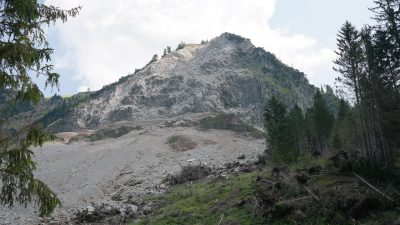Taiwan’s Deadly Wake-Up Call And The Unseen Cost Of Nature’s Fury
Typhoon Fred, which struck Taiwan in 1994, was an unprecedented disaster that left a lasting impact on the nation. This storm, though initially expected to be another typical typhoon, intensified quickly, wreaking havoc and revealing the gaps in Taiwan’s preparedness for such natural calamities. The ferocity of Typhoon Fred, which caught many off guard, unleashed destructive winds and torrential rains that left parts of Taiwan devastated.
The destruction was widespread, particularly in Taiwan’s central and eastern regions, where the brunt of the storm was felt. Typhoon Fred’s intensity escalated rapidly, causing severe damage and prompting concerns about Taiwan’s capacity to deal with such extreme weather events. In addition to the immediate devastation, the aftermath raised critical questions regarding the country’s disaster response strategies and infrastructure resilience.
Typhoon Fred Strikes: A Disaster of Unexpected Proportions
Typhoon Fred made landfall in Taiwan in August 1994, bringing with it violent winds reaching speeds of up to 185 km/h and relentless rainfall. Areas across the island, particularly the central and eastern parts, experienced significant flooding, while landslides devastated the mountainous regions, cutting off access to isolated communities. The storm’s torrential rains, which in some areas exceeded 1,000 mm, overwhelmed local drainage systems, exacerbating the flooding and damage.
Despite the extensive damage, the residents of Taiwan showed remarkable determination in the face of adversity. Communities banded together to support each other, creating a network of mutual assistance as the island scrambled to cope with the crisis. The strength of local resilience was evident as people worked tirelessly to restore normalcy. In spite of the immense challenges, these efforts were key to Taiwan’s recovery and highlighted the indomitable spirit of its people during times of crisis.
The Human Tragedy of Typhoon Fred: Deaths, Injuries, and the Aftermath
- Fatalities: Typhoon Fred claimed more than 100 lives, with many others suffering serious injuries. The powerful winds and rising waters caused fatalities as individuals were swept away or trapped under collapsed structures, leading to a significant loss of life. The death toll was compounded by the slow response and difficulty in reaching affected areas.
- Destruction of Homes: Over 50,000 homes were either completely destroyed or severely damaged by Typhoon Fred. Entire families were displaced, and many were forced to seek shelter in emergency facilities. In particular, rural areas suffered the worst, where existing infrastructure failed to withstand the severity of the storm’s impact.
- Economic Costs: The economic toll of Typhoon Fred was enormous, amounting to billions of dollars in damages. The destruction of homes, crops, and businesses caused immense financial hardship, prolonging Taiwan’s recovery and straining the national economy for years to come.
Environmental Damage: Typhoon Fred’s Lasting Impact on Taiwan’s Ecosystems
The environmental effects of Typhoon Fred were just as severe as the immediate human toll. The storm triggered massive landslides, particularly in Taiwan’s rugged mountainous areas. These landslides not only destroyed infrastructure but also resulted in widespread environmental damage, including deforestation, soil erosion, and habitat loss.
Restoring Taiwan’s environment proved to be a major challenge in the aftermath. The landslides created long-term difficulties in managing the island’s natural resources. The loss of trees and the degradation of soil made the region more vulnerable to future natural disasters, while the ecological effects contributed to the disruption of local wildlife and agriculture. These environmental consequences extended the recovery period, with Taiwan facing a long and difficult journey to restore its natural balance.
Lessons from Typhoon Fred: What Went Wrong and How Taiwan Responded
Typhoon Fred exposed several vulnerabilities in Taiwan’s disaster management systems. The authorities’ initial response was criticised for being slow and insufficient, leading to delays in evacuations and emergency assistance. The absence of a streamlined evacuation protocol and a lack of timely communication between local and national governments hindered the response to the disaster, costing lives and prolonging the crisis.
The insufficient preparedness for such a powerful storm revealed critical gaps in Taiwan’s infrastructure. The government’s initial inaction and the lack of a coordinated emergency plan were stark reminders of the need for greater disaster preparedness. However, Typhoon Fred also became a turning point for Taiwan, with the government introducing more effective early warning systems and enhanced emergency management protocols to better handle future natural disasters.
The Aftermath: How Communities Were Left to Rebuild
Following Typhoon Fred, many Taiwanese communities were left to fend for themselves due to the inadequacy of initial government responses. With roads blocked and power outages widespread, residents found themselves cut off from centralised aid efforts. In these conditions, local communities took charge of their recovery efforts, offering shelter and resources to those in need.
Many of Taiwan’s rural and mountainous areas relied heavily on local volunteers, who took the lead in clearing debris, distributing food, and rebuilding homes. While government assistance eventually arrived, the first wave of recovery came from the collective strength and solidarity of the island’s people. This grassroots response to the disaster highlighted the importance of community resilience in times of crisis and underscored the need for a stronger local disaster response framework.
Political Fallout: Accountability After Typhoon Fred’s Destruction
The aftermath of Typhoon Fred was marked by political controversy and calls for accountability. Many Taiwanese citizens were frustrated with the government’s inadequate response to the disaster, accusing the authorities of failing to adequately prepare and respond in a timely manner. The public backlash highlighted widespread dissatisfaction with the handling of the storm and the government’s failure to effectively communicate with the population.
In the wake of the disaster, political leaders faced growing demands for answers. The perceived mishandling of the crisis led to a loss of public trust in the government’s ability to manage future catastrophes. This created a political environment where the need for reform and improved disaster management became an urgent priority. Despite the criticism, the long-term consequences of Typhoon Fred were integral in shaping Taiwan’s future disaster response policies.
The Lingering Consequences of Typhoon Fred: A Nation Struggling to Recover
While the immediate destruction caused by Typhoon Fred was immense, the long-term consequences were equally devastating. The psychological toll on survivors was profound, with many struggling to cope with the trauma and loss. Families displaced by the storm faced not only the loss of homes but also the emotional scars of losing loved ones or seeing their communities torn apart.
Economically, Taiwan’s recovery took years, as the island worked to rebuild infrastructure, restore agricultural production, and repair the damages caused by the typhoon. The long-lasting effects of Typhoon Fred highlighted the need for ongoing disaster preparedness and resilient infrastructure, as the lessons learned from this event would guide Taiwan’s approach to future natural disasters.
5 Short FAQs:
- How many lives were lost in Typhoon Fred?
Over 100 people died due to Typhoon Fred, and many others sustained serious injuries. - What was the economic damage caused by Typhoon Fred?
The damage from Typhoon Fred amounted to billions of dollars, with thousands of homes and businesses destroyed. - What was the initial response to Typhoon Fred?
The response was slow, and many areas were left without timely aid, forcing local communities to take action. - What improvements were made after Typhoon Fred?
Taiwan introduced better early warning systems and improved disaster management protocols following the storm. - How did Typhoon Fred affect Taiwan’s environment?
The typhoon caused significant environmental damage, including landslides, deforestation, and soil erosion.
References:
Typhoon Fred inundates Taiwan
Typhoon Fred (1994) – Wikipedia
Analyses of 1994 Typhoons in the Taiwan Region Using Satellite Data
Typhoon Induced Extreme Coastal Surge: A Case Study at Northeast Taiwanhttps://bioone.org/journals/journal-of-coastal-research/volume-18/issue-1/03-0026.1/Typhoon-Induced-Extreme-Coastal-Surge–A-Case-Study-at/10.2112/03-0026.1.full




